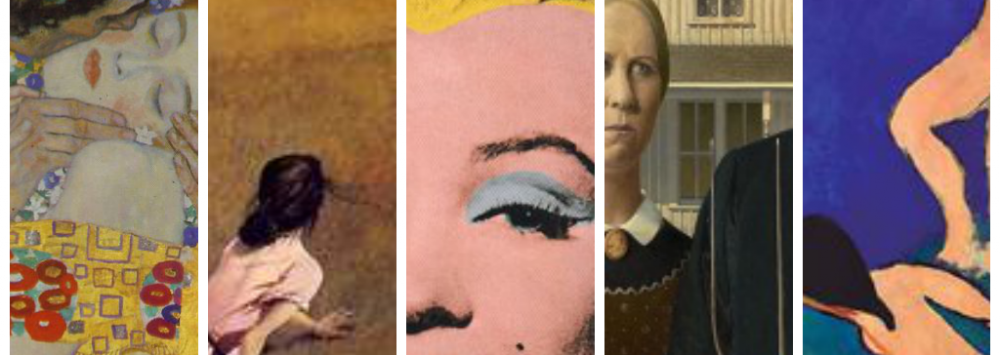
The Kiss, 1908

Water Serpents (Das Werk), 1907-8

Death and Life, 1916

The Hostile Powers, 1902

Golden Tears, Year Unknown
Biography
Born in Baumgarten, Austria in 1862, Gustav Klimt was the second of seven children. His mother, Anna Klimt, had ambitions to be a musical performer while his father, Ernst Klimt the Elder, was a gold engraver. Gustav lived in poverty with his family while studying architectural painting at the Vienna School of Arts and Crafts until 1883. In 1892, both Gustav’s father and his older brother, Erst the Second, passed away, making him the head of household responsible for supporting his family financially. This event also led Klimt to embrace a more personal artistic style as a means of coping. In the early 1890’s, Klimt met Emilie Louise Floge, who remained his companion and primary model for his portraits until his death on February 6, 1918.
Influence & Style
Klimt wrote very little about his styles and methods, once saying … He is most widely noted for his paintings, murals, and sketches, with his primary subject being the female body. Klimt began his professional career in the wake of his role models’ deaths as founding member and president of Wiener Secession, or The Vienna Succession, and its pamphlet, Ver Sacrum, or Sacred Spring, in 1897. The Vienna Succession’s purpose was to provide an outlet for unconventional young artists to pursue their passion, to bring these talented youths to Vienna, and to showcase their work. There was no particular style in the group, as it welcomed everything from Naturalists to Realists. With his erotic figure paintings, Klimt said he wanted to “shake up the establishment”. He released his first commissioned works with The Vienna Succession in 1894, and titled them Philosophy, Medicine, and Jurisprudence. All three were criticized for their radical themes, and were even deemed pornographic.
At the turn of the century, Klimt’s career entered what many call a golden phase, which took place in the first decade of the 20th century. It was during this period that his work began to warrant a more positive critical reaction and he had more financial success. It was also during this period that Klimt used gold has the main base for his portraits and landscapes. His trips to Venice and Ravenna, Italian cities famous for their beautiful scenery, were what most likely inspired Klimt to add gold to his pallet during this time in his career. Perhaps what most solidifies Klimt’s key role in the Art Nouveau movement was his involvement in the decoration of Palais Stocle, one of Nouveau’s most famous monuments. Klimt called it, “the ultimate stage of my development of ornament”.
Art Nouveau
Art Nouveau was defined by an international philosophy, symbolized by it’s many different names– Jugendstil in Germany, Modern in Russia, Modrnisave in Spain, Secession in Austria-Hungary, and Stile Liberty in Italy. The movement was most popular between 1890 and 1910 and was a reaction to academic art of the 19th century. Many see it as a bridge between the 19th century’s revival styles– Impressionism, Expressionism– and Modernism. Stylistically, Nouveau was inspired by natural forms, both environmental and artistic, as artists of the period implemented curves over straight lines. Considered a total art style, Art Nouveau incorporated architecture, graphic art, interior design, and decor.
Thoughts
I was deeply inspired by Klimt’s ability to transition from the deaths of his father and brother to his professional work. I feel as though he could have gone either way, slipping into a downward spiral of self loathe and failure, but he persevered to become the artist we remember him as today. I found the societal impact of his earlier work similar to that of the Impressionists and Dadists, challenging convention and “shaking up” the establishment. A piece I neglected to mention earlier is Das Werk, which was a collection of 50 of Klimt’s most important paintings. Some told stories, served as erotic symbolism, depicted beautiful landscapes, contained biblical references, and showed portraits. The variety of these nuances in his painting symbolize his multidimensional mindset towards art, which I respect.
21st Century Comparison
Lari Pittman
Bibliography
iKlimt: The Life and Work of Gustav Klimt. N.p., n.d. Web. 23 Apr. 2014.
<http://www.iklimt.com/>.
Art 21. PBS, n.d. Web. 23 Apr. 2014. <http://www.pbs.org/art21/artists/
pierre-huyghe>.
Art Authority (Apple Application)
Gustav Klimt: The Complete Works. N.p., n.d. Web. 24 Apr. 2014.
<http://www.klimtgallery.org/home-4-48-1-0.html>.
